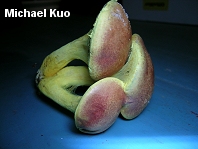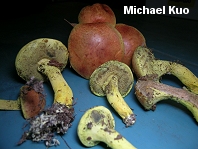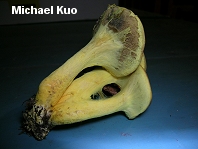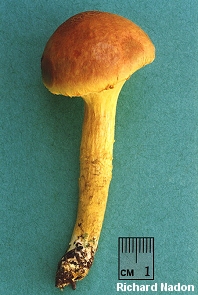| Major Groups > Boletes > Pulveroboletus ravenelii |

|
Pulveroboletus ravenelii [ Basidiomycota > Boletales > Boletaceae > Pulveroboletus . . . ] by Michael Kuo It's hard to imagine mistaking this mushroom for anything else. When young it has a powdery, bright yellow (nearly fluorescent) partial veil that covers the pore surface and sheathes the stem. In maturity Pulveroboletus ravenelii is a little less distinctive, but the colors, the presence of veil remnants on the edge of the cap, and the blue bruising should still separate it fairly easily. Pulveroboletus ravenelii is very widely distributed in North America, but appears to be more commonly encountered in the south. It is a mycorrhizal partner with conifers and, occasionally, with hardwoods. Description: Ecology: Mycorrhizal, primarily with conifers (especially pines, eastern hemlock, and spruces) but also with hardwoods (including oaks, manzanita, and rhododendron); growing alone, scattered, or occasionally in small clusters; summer and fall (also early winter on the West Coast); widely distributed in North America but more common in the south. Cap: 2-12 cm; convex to broadly convex or nearly flat in age; at first covered with bright yellow partial veil material, but soon brick red to orangish, reddish, or reddish brown centrally and yellow along the edge; dry or a little sticky after the yellow veil has disappeared; smooth; the edge often hung with veil remnants. Pore Surface: At first covered with a bright yellow veil; whitish at first, becoming yellow to yellowish brown or olive; bruising greenish blue; pores round or angular, 1-3 per mm; tubes to 1 cm deep. Stem: To 15 cm long and 2 cm thick; equal or tapering to the base; yellow or whitish; sometimes with a flimsy ring; basal mycelium whitish or yellowish. Flesh: Whitish or pale yellow throughout; usually bluing faintly in the cap when sliced, and pinkish in the stem. Odor and Taste: Taste not distinctive, acetic, or acrid; odor not distinctive. Chemical Reactions: Ammonia brownish on cap; negative on flesh; KOH orange on cap, orange on flesh; iron salts negative on cap, orangish on flesh. Spore Print: Olive. Microscopic Features: Spores 9-12.5 x 4.5-6.5 µ; smooth; long-ellipsoid. Hymenial cystidia fusoid-ventricose; often inconspicuous; to about 50 X 12 µ. Pileipellis a cutis of elements 2.5-6 µ wide; yellow in KOH. REFERENCES: (Berkeley & Curtis, 1853) Murrill, 1909. (Saccardo, 1888; Coker & Beers, 1943; Snell & Dick, 1970; Smith & Thiers, 1971; Smith, Smith & Weber, 1981; Weber & Smith, 1985; Arora, 1986; Phillips, 1991/2005; Lincoff, 1992; Metzler & Metzler, 1992; Both, 1993; Bessette, Roody & Bessette, 2000; Roody, 2003; Miller & Miller, 2006; Ortiz-Santana et al., 2007; Binion et al., 2008.) This site contains no information about the edibility or toxicity of mushrooms. |
© MushroomExpert.Com |
|
Cite this page as: Kuo, M. (2006, November). Pulveroboletus ravenelii. Retrieved from the MushroomExpert.Com Web site: http://www.mushroomexpert.com/pulveroboletus_ravenelii.html |



